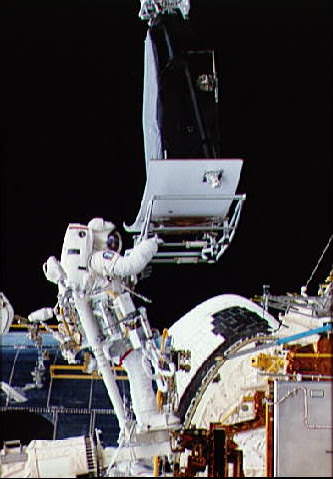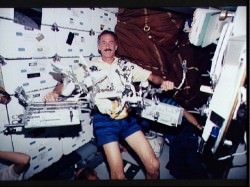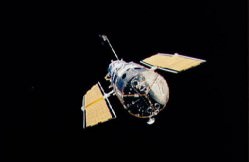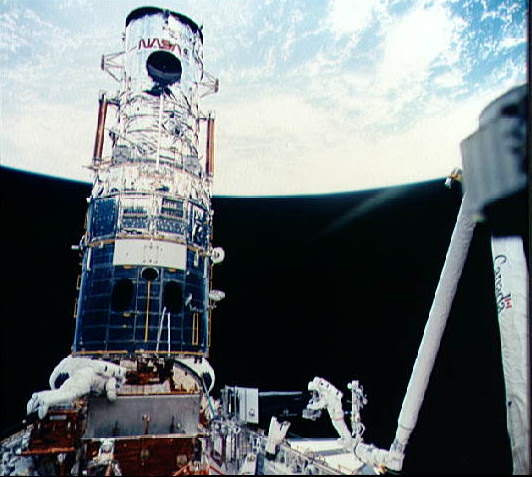[/caption]
Not surprisingly, former astronaut Jeff Hoffman has been watching the current Hubble servicing mission with interest. After all, he was a member of the first repair crew that visited the telescope in December 1993, part of the team which essentially rescued the Hubble program from what could have been a disaster. But, now Hoffman is impressed with this current crew and what they’ve accomplished, saying they are part of a “brotherhood of Hubble warriors.”
And Hoffman is feeling a little nostalgic, too.
“It certainly brought me back 15 years to when I was doing that job,” he told Universe Today. “I look at them floating around Hubble, seeing images from their helmet cameras and watching them work with all those tools, and I feel a little heart tug. But also, I feel tremendous excitement because every time we go up there we just make Hubble better and better. It’s just a phenomenal story.”

One of Hoffman’s tasks on the first Hubble repair mission, STS-61, was to install the Wide Field Planetary Camera 2. Later nicknamed “The Camera that Saved Hubble,” WFPC2 replaced the original optical camera on Hubble, and was constructed to work with the corrective optics instrument (COSTAR) – basically a set of eyeglasses to overcome the spherical aberration in Hubble’s primary mirror.
“I put the Wide Field Planetary Camera 2 in Hubble in 1993,” Hoffman reminisced, “and that is the camera that has taken the majority of the spectacular pictures by which the whole world has come to know Hubble. This crew has removed it now and replaced it with an even more powerful camera. So I had kind of a bittersweet moment when I saw “my camera” leaving the telescope!”
But he said he is looking forward to seeing even more spectacular images from WFPC3. Plus, Hoffman has been invited to Goddard Space Flight Center to see his old camera when it returns from space. “I’ll get to put my hands on it once again after fifteen years.”

For Hoffman, what is most remarkable about the current mission was the type of work the astronauts were able to do, and the panoply of tools they had at their disposal. “One of the fantastic developments is the ability for astronauts to do complex servicing, and the tools are really what make these tasks possible,” he said. “Wearing astronaut gloves, you are really pretty clumsy. It’s like wearing welder’s gloves or ski mittens and trying to do brain surgery. But the engineers have now developed a whole suite of tools optimized for the individual tasks, allowing what would otherwise be impossible to come within the realm of what an astronaut dressed in a spacesuit can accomplish.”
The electronics on two of Hubble’s instruments had failed, — the Space Telescope Imaging Spectrograph (STIS) and the Advanced Camera for Surveys (ACS) — and the STS-125 crew basically went into the electronic guts of both instruments, pulled out circuit boards and replaced them.
Seeing the astronauts make repairs at that level was a marvel, Hoffman said. “That is something which we never imagined doing with Hubble. But it just shows how with every mission we’ve gotten more and more willing to push the envelope.”

Hoffman retired from NASA in 1997 and is now a professor of aeronautics and astronautics at MIT. He believes Hubble’s greatest legacy is how the observatory has impacted society.
“People all over the world have developed a love for Hubble,” he said, “and from Hubble we have the knowledge that the Universe is a stranger and more beautiful place that any of us had ever imagined. That’s what Hubble has done for people, giving us breathtaking images that are in some cases more beautiful than any abstract artist could come up with.”
But it’s not just the beautiful pictures. “The power of Hubble to show us what the Universe is like just one or two billion years after the Big Bang, where we can actually see the birth of the first few galaxies that were forming in our universe — this is mind boggling stuff. Hubble has re-written astronomy textbooks over the years and with the new set of instruments having even more sensitivity, it’s going to happen all over again.”

Now that the current crew has released Hubble, Hoffman recalled watching the telescope float away after the completion of his own mission. “They were probably looking at it with the same feeling of nostalgia as we did as we watched it slowly drift away,” he said. “It’s kind of a fraternity of Hubble, all the people in the six crews who have been involved with the Hubble Space Telescope. Every time I see someone from the crews that have worked on Hubble or the thousands of people on the ground who have been involved with it over the years, it’s like a brotherhood/sisterhood of Hubble warriors, so to speak. It’s been just an incredible adventure and it is nowhere near the end yet. I look forward to another 5, 10, maybe 15 years of incredible discoveries coming down from the Hubble Space Telescope.”


Happy days! I’ve been away for work for two weeks, but have literally moved heaven and
Earth to follow this mission. I couldn’t be happier with it all…
Any Hubble servicing astronaut can take tremendous pride in the fact that they have directly contributed to the tremendous advancement of human knowledge.
Just wait until the IMAX movie in Spring of 2010!